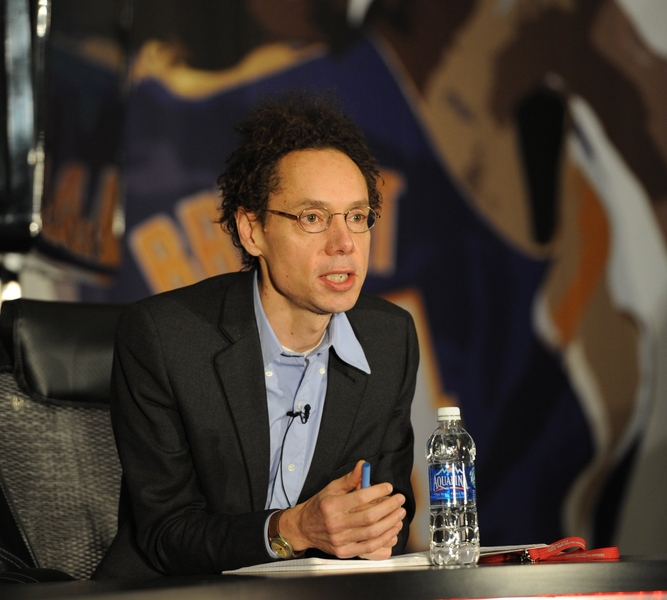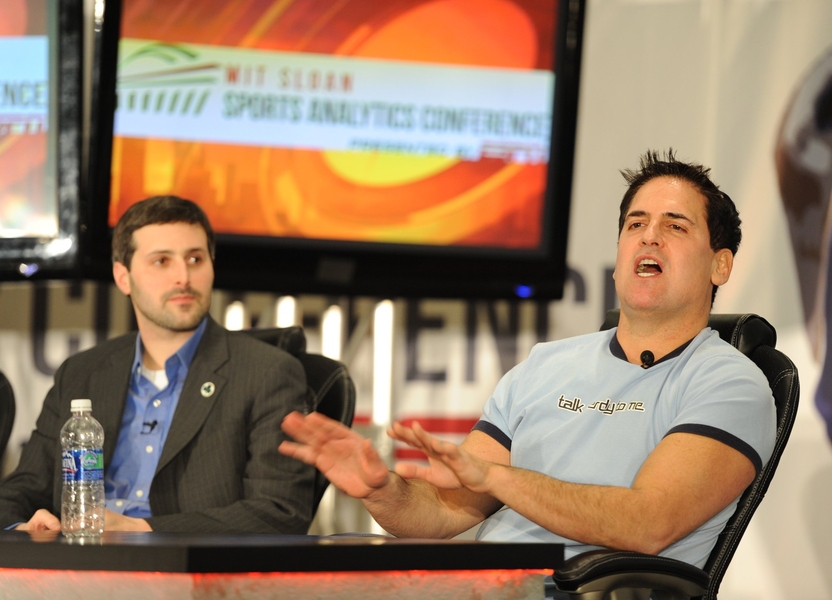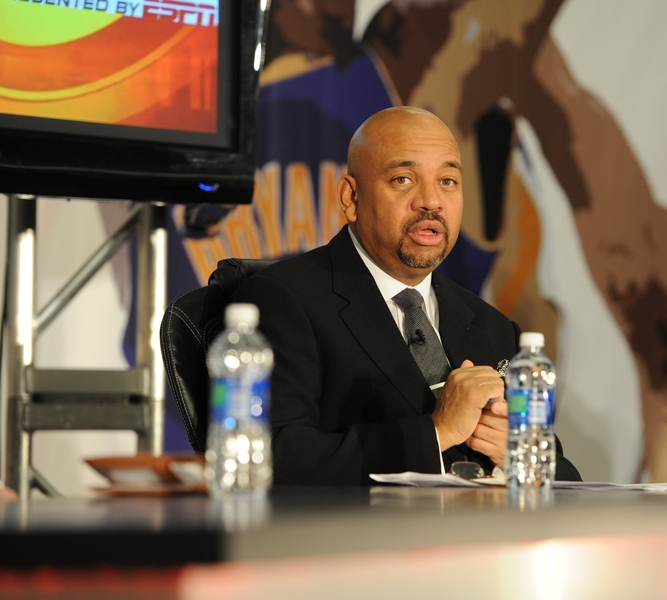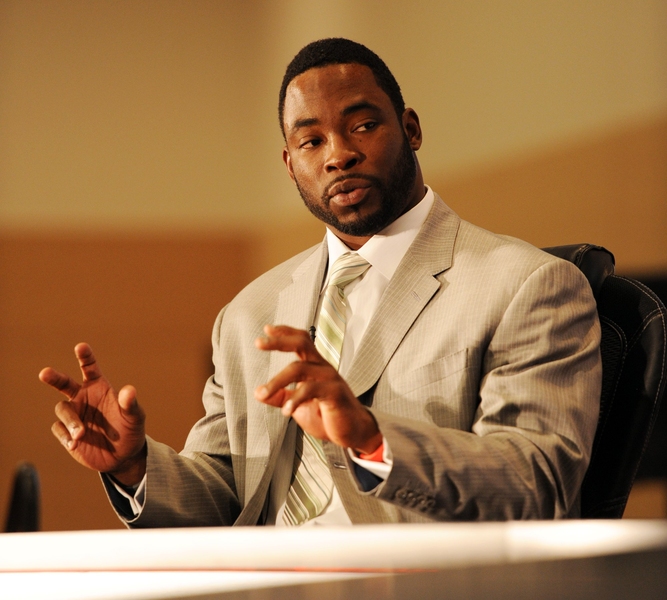Before the information revolution of recent decades, sports analysis largely consisted of vague talk about the intangible qualities of players and teams: games and championships were often said to be won because of heart, will and clutch ability.
Then sports fans started getting their hands on statistics, and before long, mainstream sports discussions began revolving around numbers-based arguments about the objective quality of players and teams.
“The psychologists were dethroned by analytics,” noted writer Malcolm Gladwell, moderating a panel at the MIT Sloan Sports Analytics Conference, held on March 4 and March 5 at the Boston Convention and Exhibition Center.
In overthrowing decades of conventional thinking, sports analytics tend to emphasize the efficiency of athletes and teams, so percentage-based stats are most important. In baseball, on-base and slugging percentages matter more than, say, runs batted in. In basketball, shooting percentage is vital, not just points scored.
The MIT conference convenes sports executives — such as Daryl Morey, SM ’00, the general manager of the NBA’s Houston Rockets and a co-founder of the conference, and Mark Cuban, owner of the NBA’s Dallas Mavericks — with analysts and media figures, such as ESPN’s Bill Simmons and Michael Wilbon. This year’s event featured more than 20 panels and 100-plus speakers, with 1,500 attendees including analysts from 36 different professional sports teams. An academic research-paper competition drew more than 100 entries, and non-sports companies such as Google and Goldman Sachs sent representatives to hunt for sharp analytical minds and new trends.
Nonetheless, many panelists noted the limits of analytics. “We’re trying to predict the future, and there is error inherent in that,” said Joe Bohringer, SM ’93, a scout for baseball’s Arizona Diamondbacks.
Moreover, teams are still struggling to determine which of their prospects have the mentality needed to succeed, a major conference theme. “Now that we’ve ensconced analytics into the game, we [also] want psychology,” Gladwell added.
Don’t kill the ump; just influence him
Sports analytics first earned national exposure through Bill James’ annual Baseball Abstract books in the 1980s, which exploded many baseball myths. The field gained cachet after Michael Lewis’ 2003 bestseller Moneyball showed how baseball’s Oakland Athletics built their organization around Jamesian analysis. Baseball analytics is now a mature field with debates revolving around details, not general principles.
But blockbuster work in sports analytics is still possible, and this year’s conference featured one such presentation: Economist Tobias Moskowitz, of the University of Chicago’s Booth School of Business, who with journalist Jon Wertheim has found compelling evidence that home-field or home-court advantage in all major team sports is principally due to the influence of referees. Crowds exert pressure on referees, who avoid incurring the wrath of fans by making close calls that consistently favor home teams.
“There’s no conspiracy here,” Moskowitz told a standing-room only crowd at his talk on Friday. Rather, he said, referees do “a great job” in relative terms, but still tend to favor home teams because “they’re human. Psychology and social pressure is very powerful.”
Moskowitz and Wertheim have ruled out other factors that might create home-team advantage. Athletes are not more energetic at home (major-league pitchers throw at the same velocity at home and on the road); opponents are not intimidated by the crowds (basketball players make free throws at the same rate whether home or away); and the rigors of travel only have a modest effect in one league, the NBA (and visiting teams that travel small distances fare no differently than those traveling long distances).
Instead, to cite one example, baseball umpires instinctively favor home teams, as the researchers found by studying the locations of about a million pitches through Pitch F/X, a video tracking system. When the NFL adopted instant replay in 1999, for definitive rulings on some plays, fumble recoveries awarded to home teams dropped by 30 percent. When Italy’s top soccer league, Serie A, played games with no fans a few years ago due to prior spectator violence, home-field advantage dropped by 80 percent. “Referees, we believe, tend to see things the way the crowd does,” said Moskowitz (who with Wertheim writes about the findings in a new book, Scorecasting.)
Managing the managers
Another prevalent theme at the conference was the need to translate the insights of analytics into practical suggestions for skeptical coaches.
“The biggest challenge we have is how to give our input to managers,” said Blake Wooster, head of the business development team at Prozone, a British firm that uses elaborate in-stadium video systems to develop soccer statistics.
But some managers do use metrics. In the English Premier League, apparently traditionalist manager Sam Allardyce of the also-ran club Bolton Wanderers quietly started using analytics several years ago. At the soccer analytics panel, analyst Gavin Fleig, then with Bolton, recounted how he helped research ways to make Bolton more effective at the scoring opportunities that arise from free kicks, corner kicks and long throw-ins; the club finished as high as seventh one season. On a football analytics panel, former New York Jets and Cleveland Browns head coach Eric Mangini said he used analytics for everything from game strategy — such as when to go for it on fourth down — to assessing his team practices.
Elevated analysis
Inside professional teams or outside them, sports analytics still boils down to curious minds answering unresolved questions. Consider Tyler Williams, a third-year PhD student in MIT’s Department of Economics who typically examines education issues, but had an entry in the conference’s research-paper track, “The Effects of Altitude on Soccer Match Outcomes.”
FIFA, soccer’s international governing body, has sometimes barred South American countries — principally Bolivia, Colombia and Ecuador — from playing home matches in high-elevation cities where opponents struggle to acclimate.
Williams looked at the numbers, isolating the effects of altitude by examining what happens when the same matchups occur at lower altitudes. The result: Visiting teams perform especially poorly in Quito, Ecuador (elevation 9,200 feet), and La Paz, Bolivia (elevation nearly 12,000 feet), but play well in Bogota, Colombia (elevation roughly 8,000 feet). Thus, Williams, concludes, “stadium altitudes should not be restricted” below Quito’s level.
Sports analytics, Williams said to MIT News, is similar to macroeconomic analysis; in both cases, researchers try to tease determining causal factors out of complicated events that never precisely repeat. “It’s a bit like trying to analyze an economy when you can’t do an experiment on it,” noted Williams. “There are interesting problems in sports analytics, and there is something to learn from it.”
At MIT’s annual sports analytics conference, owners, coaches and statistics mavens convene to ask how numbers can help increase success.
Publication Date:

Caption:
Writer Malcolm Gladwell moderates a discussion on identifying and developing athletic talent.
Credits:
Photo: Grazier Photography

Caption:
Boston Celtics Assistant General Manager Mike Zarren, left, and Dallas Mavericks owner Mark Cuban at a panel discussion of basketball analytics.
Credits:
Photo: Grazier Photography

Caption:
ESPN writer and television host Michael Wilbon leads a discussion on the contract decisions of superstar athletes.
Credits:
Photo: Grazier Photography

Caption:
MIT Sloan School of Management Dean David Schmittlein, left, and Houston Rockets General Manager Daryl Morey SM ‘00 share a laugh at the start of the conference.
Credits:
Photo: Grazier Photography

Caption:
New York Giants defensive end Justin Tuck discusses how to develop talent in professional football.
Credits:
Photo: Grazier Photography





